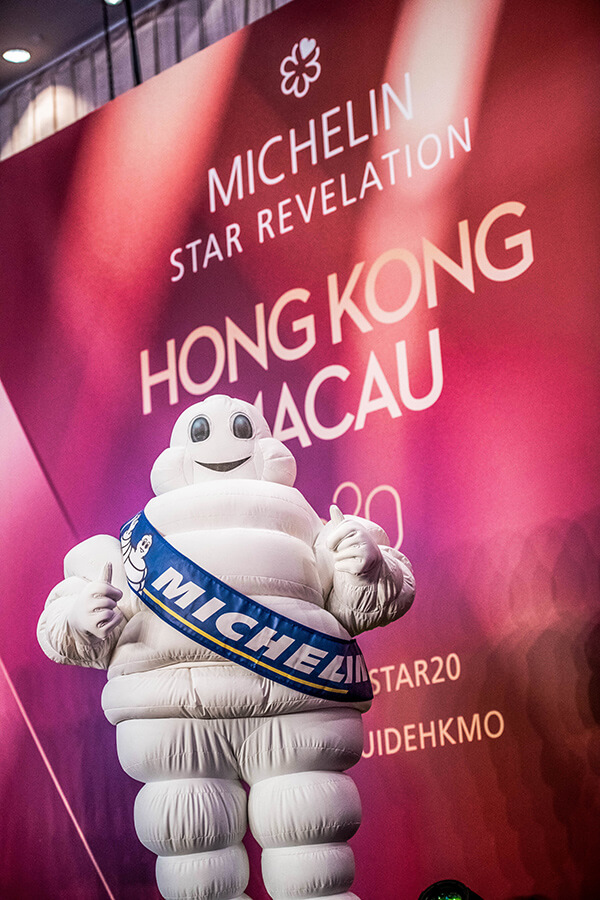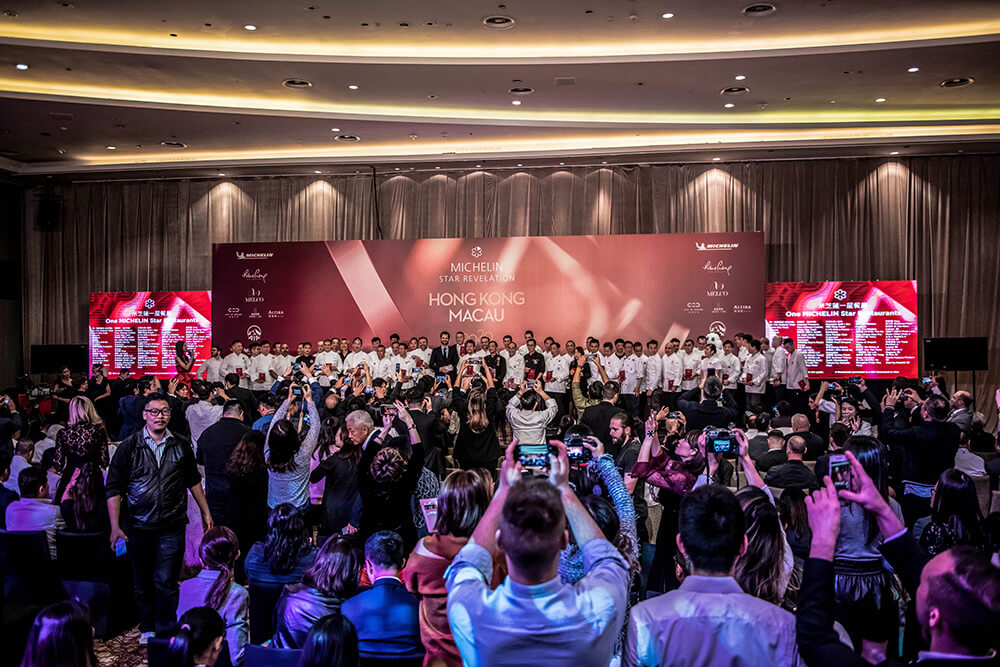Top gastronomy is highly competitive, and careers depend on prestige. As fast as a Michelin star appears on the heavens, it can also just as quickly burn out. The world’s best chefs work day and night under high pressure to win the award – sometimes for their entire lives. If you already have a Michelin star, you immediately start lusting after the next one. Once you’ve reached the star-studded heavens of the elite, you never want to leave. Hello hours and hours of overtime, goodbye private life.
Because of this, more and more top chefs are getting off the star carousel and are defying the rules and laws of the star universe. Nevertheless, the Michelin Guide still remains the gourmet bible. What are the criteria for awarding the stars? Who gets to decide? And is the whole thing fair?
Star hour in gastronomy: why a tire manufacturer has the say in culinary careers
Who doesn’t recognize the portly Michelin man? The French tire manufacturer with this funny – ok, let’s be honest, creepy – mascot discovered a profitable gap in the market in 1900. Michelin’s tourism department had a brilliant idea: a practical list of mechanics, car care tips and a map were all included in the guide. There was no better way to market their expertise to the target group. At first the guides were free, and later the customer had to pay for them. But that didn’t matter because the Michelin Guide basically has no competition. It goes without saying that this practical guide was not only popular with the French, it became a big hit in Europe as well.

Michelin Man at the Michelin Star Revelation Hong Kong Macau 2020
The travel guide started offering recommendations about hotels and restaurant in the 1920s. However, if you think the Michelin Guide only covers expensive gourmet cuisine, you are mistaken: The guide includes – back then as well as today – recommendations for every price class. The particularly exceptional locations have been marked with a symbol since 1926: a flower-shaped star which the French affectionately call “macaron”. In 1936, Michelin introduced the three categories for star chefs and star restaurants it still uses today throughout the world:
- One star: this restaurant represents “a very good restaurant” worth a stop*
- Two stars: this restaurant boast “excellent cooking” that is “worth a detour”*
- Three star: this restaurant offers “exceptional cuisine” that is “worth a special trip”*
*in its own particular category
Anonymous inspectors in search of a culinary kick: how the Michelin Guide makes its decisions
White Alba truffle, caviar and beef tatar, souffled quail breast, champagne cream sorbet: If you are willing to endure regular seven-course menus and enjoy hanging out in trendy gourmet restaurants, you should think about a professional future as a Michelin critic. Prerequisite: You have received a culinary education in an upscale establishment, have excellent taste buds and know the ins and outs of Sot-l’y-laisse, Vin Jaune or Nouvelle Cuisine.
However, it’s still no simple feat to be hired as a Michelin critic, even if you meet all the requirements. Even if you do make it, you will be faced with a lot of strenuous 14-hour days, despite the culinary delights, on which you will cover many miles from one work assignment to the next. Of course, Michelin is always connected to cars.
But with the funaside: After months of training, you and your colleagues will decide on the livelihoods of others. You assess anonymously and undercover in hotels and restaurants. You’ll have to write your report late at night – a note pad would expose you by the main course. The Michelin Guide accepts applications, but the editorial staff alone decides which locations are reviewed. That’s why you always have to keep your eyes and ears open and listen to the whispering within the industry, lurking around to catch insider tips and track down new restaurants or cuisines that are considered to be potential stars.
Michelin has long since stopped awarding prizes only to the old masters of French “haute cuisine”; the search for star chefs has long ceased to be limited to Europe alone. In recent years, this world of stars has sought to become more diverse. For example, Jay Fai, the cook at a run-down street food stall in Bangkok, Thailand’s bustling megacity, was awarded a Michelin star in 2017. The Michelin Guide wants to be modern, open and innovative – will it be able to achieve this?
Far from the hype: how restaurateurs successfully seize Michelin stars
The top restaurateurs break with tradition. Whereas silver flatware, white tablecloths and elegant evening dresses used to be the standard of every gourmet temple in the past, today there is a striking difference.
Although you can still find the classic fine star restaurant complete with an attendant who helps ladies out of their fur coats, new forms are on the rise, especially in big cities: At these place the guests learn something, the evening becomes a funny group event and lobster is served on a slate instead of porcelain. The Michelin Guide is increasingly honoring such locations with the distinction of being a star restaurant. After all, whether street food, a bistro or a fine restaurant: the Michelin star only rates the cuisine. For those who particularly care about ambience and comfort, the Michelin Guide awards the stars and silverware symbol up to five times per restaurant.
Far removed from the hype surrounding molecular cuisines, minimalism or internationalization, the rules remain the same when awarding Michelin stars. What distinguishes an excellent meal from an average good meal does not change – whether exotic or regional. The Michelin critic evaluates each 3-course menu according to the following criteria:
- The ingredients are high quality and fresh, and are professionally prepared to perfection.
- The dishes taste superb and have a creative, personal touch.
- The price-performance ratio is good and all the meals on the menu are consistently excellent across the board.
And so the 85 Michelin inspectors travel around the world, busily sampling goose liver and Breton lobster, and afterward penning reviews that can change the future of chefs and restaurants forever. Before a Michelin star is awarded or taken away, several inspectors test the restaurant. However, the testers stay initially anonymous; no one can tell them apart from a normal guest. They often out themselves at the end of the visit – by then it is of course too late to offer them any kind of special treatment. One of them could show up any day at any time. It goes without saying that the pressure on chefs and staff intensifies as a result of such a process.

Michelin Star Revelation Hong Kong Macau 2020
Loneliness in the starry sky: the blessing and curse of a Michelin star
The tone is rough, the statements straightforward – this probably holds true for the communication in most kitchens. But if small mistakes can lead to termination, this is clearly noticeable in the team. Everyone has to be at the top of their game, and completely present. Every handle has to fit, every detail has to be perfect – ok, it’s not like every restaurateur is as determined about their dream of attaining a place in the starry sky. But many staff members nevertheless recount the pressure in top gastronomy caused by the battle for stars, coins and points.
After all, the inspectors for the Michelin Guides are not the only ones who judge the quality of restaurants. The restaurant guide market is highly sought after. However, not everyone tests the reviews themselves, and anyone who compares them soon notices that the industry often copies what the others have already said. Nevertheless, numerous new editions appear every year in the late fall. The Varta guide gives up to five diamonds, the Gault-Millau awards the best chefs with 20 points and four chef’s hats, the Schlemmer Atlas uses cooking spoons – and countless other restaurant guides give grades and ratings.
The German restaurant guide Gusto follows a particularly controversial path: Everyone who appears in it with a photo and a detailed description has paid for this. However, Gusto also rates other restaurants – but without a photo and a long review – and claims the payment has no influence on the rating. In fact, it is now the second most popular and influential restaurant guide – right after the Guide Michelin. But whether asked, paid for or uninvited for inspection: The fact that those who perform badly in these rating tiers are unhappy is obvious.
But why on earth do chefs who are awarded top grades complain? That’s easy: They don’t want to be pigeonholed with upscale, expensive gourmet joints, they don’t want to attract gourmet tourists or simply don’t want to expose themselves to the pressure of success inherent in the process. More and more chefs prefer creative freedom and independence; they want to do their own thing and don’t give two hoots about getting their own Michelin star – after all, they can’t take it with them when they leave the restaurant where they cooked up the star. In this case, the restaurant also loses its star.
Burnout, no thanks: the star boycott of top chefs
They conjure up the most unusual dishes on the plate and take their guests into a culinary world for which they willingly pay a multi-figure sum of admission: and all this without a single Michelin star. More and more top chefs are breaking new ground, freeing themselves from the battle for awards – and still remaining successful. Like Maria Groß, whose star appeared in the Michelin heavens in 2013. At the time 33, Germany celebrated her as its youngest star chef. But the young woman threw her career as a star chef out the window and instead founded her own restaurant in 2015, where the rules of Michelin, Gault-Millau and Co. don’t apply, but rather her own. She is part of a new generation of top chefs who no longer want to follow the rules of the game.
Sieh dir diesen Beitrag auf Instagram an
There are dozens of other examples. We all remember the scandal in 2017 when French star chef Sébastien Bras announced to the media that he would hand in his three stars for his culinary skills at the gourmet restaurant Le Suquet in Auvergne. One year later the Michelin Guide lists him nevertheless, this time with two stars. Because which restaurant appears in the restaurant guide and which one does not is left to the freedom of the press. Nevertheless, Michelin, Varta and Gault-Millau are sometimes not mentioned by name as a sign of goodwill – and more and more chefs and restaurateurs are publicly expressing their wish not to list their establishment as a star restaurant.
The satisfaction of the guests: the best award for a chef?
Let’s be honest here: Are we happy with how much power the big restaurant guides now have over us? Is it fair that their verdicts can end entire careers? There are rumors and talk of agreements made in the industry. Far too often the decisions on awarding contracts are hard to understand; a new generation of top chefs refuses to follow the traditional hierarchy. Are “average” guest perhaps the best jury for a chef?
Yes and no. Thanks to social media, every indiscriminate opinion has taken on weight. A trained industry professional with expert knowledge may not always recognize a star chef – but they still do so more reliably than Joe Schmo from Any Town, USA, who posts a bitterly negative review of a restaurant on Facebook which more describes a disappointing encounter with his ex-wife rather than reflecting on Michelin criteria. Objectivity and expertise are qualities that restauranteurs value. Not everyone knows much about gourmet cuisine – and that’s ok.
The problem is therefore not the professional evaluation itself, but rather the overwhelming importance of individual awards and the resulting pressure. But don’t worry, even if the power of Michelin, Varta, Gault-Millau and Co. diminishes: The pursuit of excellence, the passion for cooking and the search for unique culinary experiences will not stop. To use the four simple words as said by Thomas Keller, successful star chef and owner of a restaurantimperiums: “Food should be fun!”
















